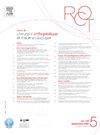Cyphose jonctionnelle proximale au-dessus des fusions rachidiennes étendues
Q4 Medicine
Revue de Chirurgie Orthopedique et Traumatologique
Pub Date : 2024-08-26
DOI:10.1016/j.rcot.2024.06.014
引用次数: 0
Abstract
Introduction
La déformation rachidienne de l’adulte est un problème de santé publique majeur. Après échec du traitement médical, la chirurgie d’arthrodèse permet une amélioration clinique et radiologique. Cependant, les complications mécaniques et plus particulièrement les cyphoses jonctionnelles proximales (CJP) sont fréquentes avec une incidence comprise entre 10 à 40 % selon les études.
Analyse
De nombreux facteurs de risque ont été identifiés, regroupés en trois catégories. Parmi ceux liés au patient, l’âge avancé, les comorbidités, l’ostéoporose et la sarcopénie jouent un rôle déterminant. Les modifications de l’alignement sagittal (déplacement du point d’inflexion en direction crâniale, excès de correction de la lordose lombaire supérieure, cyphose thoracolombaire préopératoire) jouent un rôle primordial. Enfin, la technique de l’arthrodèse elle-même peut augmenter le risque de CJP (utilisation de vis plutôt que de crochets).
Prévention
La prévention intervient à chaque phase du traitement. En préopératoire, une évaluation des patients permet de rechercher ceux à risque de CJP. Un traitement de l’ostéoporose a son intérêt. Il faut également adapter la stratégie chirurgicale : le choix d’implants transitionnels tels que les liens sous-lamaires ou crochets, et l’utilisation de techniques de renfort ligamentaire peuvent permettre de minimiser le risque de CJP. Enfin, un suivi clinique et radiologique attentif permet de détecter précocement tout signe de CJP et de réintervenir de manière précoce.
Traitement
Toute CJP ne nécessite pas une reprise chirurgicale. Un suivi radiologique et un traitement fonctionnel peuvent parfois suffire. Cependant, en cas de symptomatologie douloureuse, de complication neurologique ou d’instabilité décelée par l’imagerie (fracture instable, spondylolisthésis, compression médullaire), une réintervention s’impose. Elle consiste en une extension proximale de l’arthrodèse, associée à une libération des niveaux comprimés a minima.
Conclusion
La CJP représente un défi majeur pour le chirurgien. Le meilleur traitement reste préventif, avec une analyse adéquate des facteurs de risque permettant une chirurgie planifiée et personnalisée. Un suivi postopératoire régulier est indispensable.
Niveau de preuve
Expert.
Introduction
Spinal deformity in adults is a major public health problem. After failure of conservative treatment, correction and fusion surgery leads to clinical and radiological improvement. However, mechanical complications and more particularly – proximal junctional kyphosis (PJK) – are common with an incidence of 10 % to 40 % depending on the studies.
Analysis
Several risk factors have been identified and can be grouped into three categories. Among the patient-related factors, advanced age, comorbidities, osteoporosis and sarcopenia play a determining role. Among the radiological factors, changes in sagittal alignment (cranial migration of cervicothoracic inflection point, over-correction of lumbar hyperlordosis, preoperative thoracolumbar kyphosis) play a key role. Finally, the fusion technique itself may increase the risk of PJK (use of screws instead of hooks) as a surgical factor.
Prevention
Prevention happens at each phase of treatment. A patient assessment is done preoperatively to identify those at risk of PJK. Treating osteoporosis is beneficial. The surgical strategy must also be adapted: the choice of transitional implants such as sublaminar links or hooks and the use of ligament reinforcement techniques can help minimize the risk of PJK. Finally, methodical clinical and radiological follow-up will help to detect early signs of PJK and allow a surgeon to reoperate right away.
Treatment
Not all PJK requires surgical revision. Radiological monitoring and functional treatment is sometimes sufficient. However, if the patient develops pain, neurological complications or instability detected by imaging (unstable fracture, spondylolisthesis, spinal cord compression), revision surgery is necessary. It consists of a proximal extension of the fusion construct combined with decompression of the stenosis levels with stenosis at a minimum.
Conclusion
PJK is a major challenge for surgeons. The best treatment is prevention, with a thorough analysis of risk factors leading to a well-planned and personalized surgery. Regular postoperative follow-up is essential.
Level of evidence
Expert opinion.
脊柱广泛融合后的近端交界性脊柱后凸
导言:成人脊柱畸形是一个重大的公共卫生问题。在药物治疗失败后,关节置换手术可改善临床和放射学状况。然而,机械性并发症,尤其是近端交界性脊柱后凸(PJC)很常见,根据不同的研究,发生率在 10% 到 40% 之间。在与患者相关的因素中,高龄、合并症、骨质疏松症和肌肉疏松症起着决定性作用。矢状线的改变(拐点的颅骨移位、上腰椎前凸过度矫正、术前胸腰椎后凸)也起着关键作用。最后,关节置换技术本身可能会增加 CJP 的风险(使用螺钉而非钩)。术前对患者进行评估,以确定哪些患者有患 CJP 的风险。骨质疏松症的治疗非常有用。手术策略也需要进行调整:选择过渡性植入物,如椎板下牵引带或钩,以及使用韧带加固技术,都有助于将 PJC 的风险降至最低。最后,仔细的临床和放射学监测有助于及早发现任何 PJC 征兆,并在早期进行干预。请注意,并非所有的 PJC 都需要进行翻修手术,有时进行放射学监测和功能性治疗就足够了。但是,如果出现疼痛症状、神经系统并发症或影像学检测到不稳定性(不稳定骨折、脊柱滑脱、脊髓压迫),则需要再次手术。结论 对外科医生来说,JPC 是一项重大挑战。最好的治疗方法仍然是预防性治疗,充分分析风险因素,以便有计划地进行个性化手术。定期进行术后随访至关重要。在保守治疗失败后,矫正和融合手术可改善临床和放射学状况。然而,机械性并发症,尤其是近端交界性脊柱后凸(PJK)很常见,根据不同的研究,其发生率在 10% 到 40% 之间。在与患者相关的因素中,高龄、合并症、骨质疏松症和肌肉疏松症起着决定性作用。在放射学因素中,矢状线的改变(颈胸椎拐点的颅内移位、腰椎过度弯曲的过度矫正、术前胸腰椎后凸)起着关键作用。最后,融合技术本身可能会增加 PJK 的风险(使用螺钉而不是钩子),这也是一个手术因素。术前对患者进行评估,以确定哪些患者有发生 PJK 的风险。治疗骨质疏松症是有益的。手术策略也必须加以调整:选择过渡性植入物,如椎板下连接体或钩状植入物,以及使用韧带加固技术,都有助于将 PJK 的风险降至最低。最后,有条不紊的临床和放射学随访有助于发现 PJK 的早期征兆,使外科医生能够立即进行再手术。放射学监测和功能性治疗有时就足够了。但是,如果患者出现疼痛、神经系统并发症或影像学检测到不稳定性(不稳定骨折、脊柱滑脱、脊髓压迫),则有必要进行翻修手术。翻修手术包括将融合结构向近端延伸,同时对狭窄水平进行减压,将狭窄程度降到最低。最好的治疗方法是预防,通过对风险因素的全面分析,制定周密的个性化手术计划。术后定期随访至关重要。
本文章由计算机程序翻译,如有差异,请以英文原文为准。
求助全文
约1分钟内获得全文
求助全文
来源期刊

Revue de Chirurgie Orthopedique et Traumatologique
Medicine-Surgery
CiteScore
0.10
自引率
0.00%
发文量
301
期刊介绍:
A 118 ans, la Revue de Chirurgie orthopédique franchit, en 2009, une étape décisive dans son développement afin de renforcer la diffusion et la notoriété des publications francophones auprès des praticiens et chercheurs non-francophones. Les auteurs ayant leurs racines dans la francophonie trouveront ainsi une chance supplémentaire de voir reconnus les qualités et le intérêt de leurs recherches par le plus grand nombre.
 求助内容:
求助内容: 应助结果提醒方式:
应助结果提醒方式:


